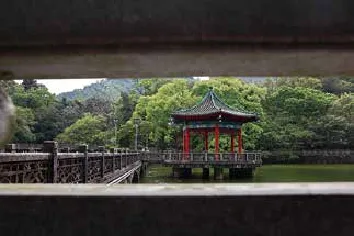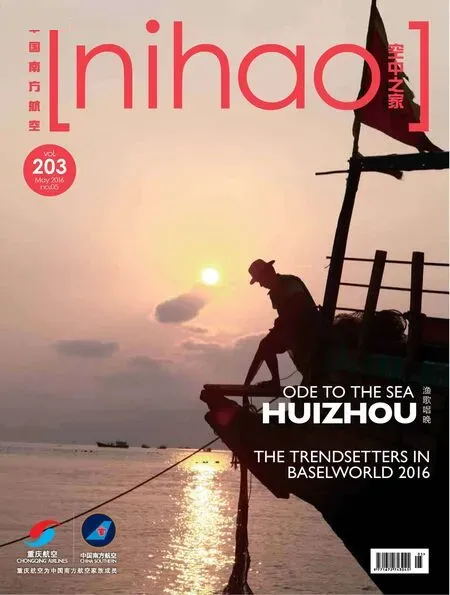千年之约:叹唯美惠州
千年之约:叹唯美惠州

A thousand years ago, the great writer Su Dongpo was banished to the south and lost his heart to Huizhou. Expressions like “Eating lychees everyday, I wouldn't mind staying in Lingnan forever” were then composed.

Located on the Tropic of Cancer, Huizhou has a history of 1,400 years. During the 1,000 years from the Tang Dynasty to the Qing Dynasty, 430 Chinese celebrities stayed or visited Huizhou and left nearly a hundred historical relics and more than 2,000 cultural relics. To fully understand Huizhou, people must know its history as well as its landscape.
West Lake: Naturally charming like light makeup
West Lake was built in the Northern Song Dynasty. Magistrate Chen Cheng fi rst introduced water from West Lake to irrigate fi elds and grow fi sh, lotuses, cattails, and reeds, bringing fertility to the prefecture. At that time West Lake was called Feng Lake (Feng means fertility in Mandarin). Embankments, bridges, and pavilions were built around or on the lake. In the fi rst-year reign of Emperor Shao Sheng in the Northern Song Dynasty (1094), Su Dongpo was banished to Huizhou and renamed Feng Lake West Lake because the lake was located on the west of Huizhou and it was as beautiful as the one in Hangzhou which he was familiar with. From then on, the lake was named West Lake. The magistrate of Huizhou in the Qing Dynasty Wu Qian compared Hangzhou West Lake with Huizhou West Lake inHuiyang Shan Shui Ji Sheng: “Hangzhou West Lake is exquisite, beautiful, and artif i cially decorated like heavy makeup, while Huizhou West Lake is extensive, secluded, and naturally charming like light makeup.”
Funded by Su Dongpo, Su Causeway is a precious historical and cultural heritage. Today, “Enjoy the Moonlight on Su Causeway” has become the top of the eight scenes at Huizhou West Lake, where visitors wander through the causeway and enjoy the lake and breeze in the moonlight.

Luofu Mountain: Herbs grow everywhere
Luofu Mountain is 60 km from Huizhou downtown. According to legend, Fu Mountain was one of the Penglai islands from the East Sea and joined with Luo Mountain. Hot and rainy, Luofu Mountain is rich in herbs due to the adequate moisture, including 1,200 or more varieties, winning the reputation for being a huge green treasure. Around 1700 years ago, Ge Hong, the Taoist, chemist, and pharmacologist in the Jin Dynasty (284~364), built the temple for Taoism practice, alchemy, and lectures and left descendants masterpieces likeBao Pu Zi, Zhou Hou Bei Ji Fang, and Jin Gui Yao Fang. He wrote inBao Pu Zi, “Along the path (in Luofu Mountain), herbs grow everywhere.”Inspired by the description and use of the sweet wormwood herb inZhou Hou Bei Ji Fang, a Chinese pharmaceutical chemist Tu Youyou discovered artemisinin - used to treat malaria - and received the 2015 Nobel Prize. As a must-visit spot, the herbal medicine washing pool is 1,200 steps from the entrance of Luofu Mountain Scenic Area. Visitors may see the monument, which states: “Qing Hao Kang Nue Zhi Yuan (which means Source of Artemisinin in Mandarin)” next to it.
Xunliao Bay: Fresh seawater, peculiar rocks, and white sand
Enjoying the reputation for being “China's Maldives”and “the Hawaii of the East”, Xunliao Bay features the magnif i cent sandy beaches and towering, jagged rocks of grotesque shapes. According to legend, the name Xunliao has connections with Su Dongpo too. When Su was banished to the south, he liked to visit Xunliao on vacation in summer. In fact, Xunliao was originally called Yaliao. Finding out that the bay resembled the shape of the eight trigrams and was located on the Xun trigram, Su then wrote “Xunliao” on the rock at the seaside. Although the legend can not be proved to be true and the inscription was never found, the landscape remains amazing: blue sky, fresh seawater, peculiar rocks, and white sand.
Fishermen in Xunliao believe in Mazu, a Chinese goddess who is said to protect seafarers. Many believers visit Mazu Temple to worship each year. Fishermen also worship Mazu before each sailing. At Xunliao, visitors may go fi shing by boat, which travels through many islands for sightseeing.
1000年前,大文豪苏东坡被贬南下,对惠州一见倾心,“日啖荔枝三百颗,不辞长作岭南人”的佳句由此诞生。择一良辰,循西湖赏月、罗浮山寻道、巽寮湾观海……与惠州古城赴一场千年之约。

惠州坐落在北回归线上,至今已有1400多年历史。从唐到清末的1000多年间,有430多位中国名人客寓或履临惠州,留下了近百处遗址和两千多件文物。要读懂惠州,不仅要看山看海,更少不了谈古论今。
惠州西湖:天然风韵,娥眉淡扫
惠州西湖始建于北宋。清代惠州知府吴骞的《惠阳纪胜》将杭州西湖与惠州西湖作了一次对比:“杭之佳以玲珑而惠则旷邈;杭之佳以韶丽而惠则幽森;杭之佳以人事点缀,如华饰靓妆,而惠则天然风韵,如娥眉淡扫。”由苏东坡出资修建的“苏堤”,是宝贵的历史文化遗产,如今“苏堤玩月”已经成为惠州西湖八景之首,月明星稀之夜,水波摇曳,漫步堤上,清风拂面,心旷神怡。
罗浮山:篱陌之间,顾盼皆药
罗浮山距离惠州城区60公里,相传浮山是蓬莱一岛,自东泛海而来,与罗山合而为一。罗浮山高温多雨,“山山瀑布,处处流泉”,百草丛生,名贵药材1200多种,堪称巨大的绿色宝藏。1700多年前,晋代道教理论家、化学家、药物学家葛洪至此建庵修炼、筑灶炼丹,著书讲学,他在《抱朴子》中写道:“(罗浮山)篱陌之间,顾盼皆药”。中国药学家屠呦呦从葛洪《肘后备急方》对青蒿的描述和使用方法中获得灵感,从而发现抗疟药物青蒿素,并荣获2015年诺贝尔奖。
巽寮湾:水清石奇,天赐白沙
巽寮湾,水清沙幼,海面壮阔,奇石耸立如天成,被誉为“中国的马尔代夫”“东方夏威夷”。当年苏公被贬,初下南方,天气闷热,喜欢到此地度假消暑,他发现整个大湾像个八卦形状,而此地处在“巽”卦上,见此地常年微风拂面,海不扬波,顺手在海边岩石挥就墨宝:巽寮。传说未经考证,当年的题字亦不可见,不过蓝天、海水、奇石、白沙都还是令人惊叹的模样。
巽寮的渔民无不信奉妈祖,这位传说中羽化成仙的美丽女子,据说可以保护出海的人平安而归。每年,巽寮湾的妈祖庙前香火旺盛,渔民出海前,都会在妈祖面前拜一拜。游客来到巽寮,可乘坐渔船出海捕鱼,做一回渔夫渔女,船只经过许多座小岛,尽览巽寮湾旖旎风光。
A THOUSAND-YEAR APPOINTMENT HUIZHOU
Text by Violet Photos by CFP, Zeng jian & Huizhou Tourism Board

